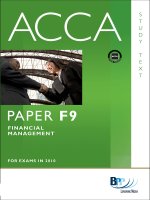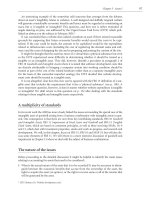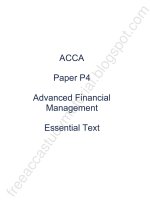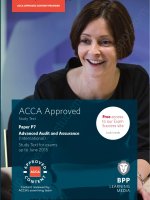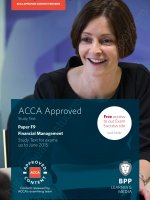2015 ACCA p4 essential text KAPLAN advanced FInancial; management essential text
Bạn đang xem bản rút gọn của tài liệu. Xem và tải ngay bản đầy đủ của tài liệu tại đây (7.63 MB, 410 trang )
m
freeaccastudymaterial.blogspot.com
co
sp
ot.
ACCA
l.b
log
ria
Paper P4
ym
ate
Advanced Financial
Management
fre
ea
cc
as
tud
Essential Text
freeaccastudymaterial.blogspot.com
sp
ot.
co
m
freeaccastudymaterial.blogspot.com
l.b
log
British library cataloguinginpublication data
Published by:
Kaplan Publishing UK
Unit 2 The Business Centre
Molly Millars Lane
Wokingham
Berkshire
RG41 2QZ
ym
© Kaplan Financial Limited, 2014
ate
ria
A catalogue record for this book is available from the British Library.
as
tud
The text in this material and any others made available by any Kaplan Group company does not
amount to advice on a particular matter and should not be taken as such. No reliance should be
placed on the content as the basis for any investment or other decision or in connection with any
advice given to third parties. Please consult your appropriate professional adviser as necessary.
Kaplan Publishing Limited and all other Kaplan group companies expressly disclaim all liability to any
person in respect of any losses or other claims, whether direct, indirect, incidental, consequential or
otherwise arising in relation to the use of such materials.
Printed and bound in Great Britain.
Acknowledgements
cc
We are grateful to the Association of Chartered Certified Accountants and the Chartered Institute of
Management Accountants for permission to reproduce past examination questions. The answers
have been prepared by Kaplan Publishing.
fre
ea
All rights reserved. No part of this publication may be reproduced, stored in a retrieval system, or
transmitted, in any form or by any means, electronic, mechanical, photocopying, recording or
otherwise, without the prior written permission of Kaplan Publishing.
ii
KAPLAN PUBLISHING
freeaccastudymaterial.blogspot.com
Contents
Page
The role and responsibility of the financial
manager
Chapter 2
Investment appraisal
Chapter 3
The financing decision
Chapter 4
The dividend decision
Chapter 5
International operations and international
investment appraisal
Chapter 6
International operations the financing decision 101
and the dividend decision
Chapter 7
Option pricing
Chapter 8
The weighted average cost of capital (WACC)
Chapter 9
Risk adjusted WACC and adjusted present value 153
Chapter 10
Corporate failure and reconstruction
171
Chapter 11
An introduction to risk management
205
Chapter 12
Hedging foreign exchange risk
225
Chapter 13
Hedging interest rate risk
257
Chapter 14
Strategic aspects of acquisitions
287
Chapter 15
Business valuation
305
Chapter 16
Topical issues in financial management
333
Chapter 17
Questions & Answers
347
ot.
Chapter 1
co
m
freeaccastudymaterial.blogspot.com
1
sp
23
61
71
113
133
fre
ea
cc
as
tud
ym
ate
ria
l.b
log
47
iii
KAPLAN PUBLISHING
freeaccastudymaterial.blogspot.com
fre
ea
cc
as
tud
ym
ate
ria
l.b
log
sp
ot.
co
m
freeaccastudymaterial.blogspot.com
iv
KAPLAN PUBLISHING
freeaccastudymaterial.blogspot.com
freeaccastudymaterial.blogspot.com
chapter
m
Introduction
fre
ea
cc
as
tud
ym
ate
ria
l.b
log
sp
Paper Introduction
ot.
co
v
freeaccastudymaterial.blogspot.com
freeaccastudymaterial.blogspot.com
How to Use the Materials
ot.
co
m
Introduction
sp
These Kaplan Publishing learning materials have been
carefully designed to make your learning experience as easy
as possible and to give you the best chances of success in
your examinations.
l.b
log
The product range contains a number of features to help you
in the study process. They include:
(1) Detailed study guide and syllabus objectives
(2) Description of the examination
(3) Study skills and revision guidance
(5) Question practice
ria
(4) Complete text or essential text
ate
The sections on the study guide, the syllabus objectives, the
examination and study skills should all be read before you
commence your studies. They are designed to familiarise
you with the nature and content of the examination and give
you tips on how to best to approach your learning.
fre
ea
cc
as
tud
ym
The complete text or essential text comprises the main
learning materials and gives guidance as to the importance
of topics and where other related resources can be found.
Each chapter includes:
•
The learning objectives contained in each chapter,
which have been carefully mapped to the examining
body's own syllabus learning objectives or outcomes.
You should use these to check you have a clear
understanding of all the topics on which you might be
assessed in the examination.
•
The chapter diagram provides a visual reference for
the content in the chapter, giving an overview of the
topics and how they link together.
•
The content for each topic area commences with a
brief explanation or definition to put the topic into context
before covering the topic in detail. You should follow
your studying of the content with a review of the
illustration/s. These are worked examples which will help
you to understand better how to apply the content for the
topic.
vi
KAPLAN PUBLISHING
freeaccastudymaterial.blogspot.com
m
freeaccastudymaterial.blogspot.com
Test your understanding sections provide an
opportunity to assess your understanding of the key
topics by applying what you have learned to short
questions. Answers can be found at the back of each
chapter.
•
Summary diagrams complete each chapter to show
the important links between topics and the overall
content of the paper. These diagrams should be used to
check that you have covered and understood the core
topics before moving on.
•
Question practice is provided at the back of each text.
l.b
log
sp
ot.
co
•
Quality and accuracy are of the upmost importance to us so
if you spot an error in any of our products, please send an
email to with full details,
or follow the link to the feedback form in MyKaplan.
Icon Explanations
ate
ria
Our Quality Coordinator will work with our technical team to
verify the error and take action to ensure it is corrected
in future editions.
ym
Definition – Key definitions that you will need to learn from
the core content.
Key Point – Identifies topics that are key to success and
are often examined.
as
tud
New – Identifies topics that are brand new in papers that
build on, and therefore also contain, learning covered in
earlier papers.
cc
Expandable Text – Expandable text provides you with
additional information about a topic area and may help you
gain a better understanding of the core content. Essential
text users can access this additional content on-line (read it
where you need further guidance or skip over when you are
happy with the topic)
ea
Test Your Understanding – Exercises for you to complete
to ensure that you have understood the topics just learned.
fre
Illustration – Worked examples help you understand the
core content better.
vii
KAPLAN PUBLISHING
freeaccastudymaterial.blogspot.com
freeaccastudymaterial.blogspot.com
m
Introduction
co
Tricky topic – When reviewing these areas care should be
taken and all illustrations and test your understanding
exercises should be completed to ensure that the topic is
understood.
ot.
Tutorial note – Included to explain some of the technical
points in more detail.
sp
Footsteps – Helpful tutor tips.
Syllabus
Paper background
Objectives of the syllabus
Syllabus objectives
ate
The examination
ria
Core areas of the syllabus
l.b
log
Online subscribers
Examination format
Examination tips
ym
Study skills and revision guidance
Preparing to study
as
tud
Effective studying
Three ways of taking notes
Revision
You can find further reading and technical articles under the
student section of ACCA's website. Also, you may find it
useful to read "Corporate Finance and Valuation" by Bob
Ryan (the P4 examiner). Several theories and methods from
this book appear in this Kaplan Text with the kind
permission of the author.
fre
ea
cc
Further reading
viii
KAPLAN PUBLISHING
freeaccastudymaterial.blogspot.com
chapter
1
m
freeaccastudymaterial.blogspot.com
ot.
co
l.b
log
sp
The role and responsibility
of the financial manager
Chapter learning objectives
Study guide section
Study guide outcome
(b) Recommend strategies for the
management of the financial
resources of the organisation such
that they are utilised in an efficient,
effective and transparent way.
(c) Advise the board of directors or
management of the organisation in
setting the financial goals of the
business and in its financial policy
development with particular
reference to: (i) Investment selection
and capital resource allocation (ii)
Minimising the cost of capital (iii)
Distribution and retention policy (iv)
Communicating financial policy and
corporate goals to internal and
external stakeholders (v) Financial
planning and control (vi) The
management of risk.
fre
ea
cc
as
tud
ym
ate
ria
A1: The role and
(a) Develop strategies for the
responsibility of the senior
achievement of the organisational
financial executive / advisor
goals in line with its agreed policy
framework.
1
freeaccastudymaterial.blogspot.com
l.b
log
sp
ot.
A3: Conflicting stakeholder (a) Assess the potential sources of the
interests
conflict within a given corporate
governance/
stakeholder framework informed by
an understanding of the alternative
theories of
managerial behaviour. Relevant
underpinning theory for this
assessment would be: (i) The
separation of ownership and control
(ii) Transaction cost economics and
comparative governance structures
(iii) Agency Theory.
co
The role and responsibility of the financial manager
m
freeaccastudymaterial.blogspot.com
(b) Recommend, within specified
problem domains, appropriate
strategies for the resolution of
stakeholder conflict and advise on
alternative approaches that may be
adopted.
fre
ea
cc
as
tud
ym
ate
ria
(c) Compare the different governance
structures and policies (with
particular emphasis upon the
European stakeholder and the
US/UK shareholder model) and with
respect to the role of the financial
manager.
2
KAPLAN PUBLISHING
freeaccastudymaterial.blogspot.com
freeaccastudymaterial.blogspot.com
sp
(b) Demonstrate an understanding of the
interconnectedness of the ethics of
good business practice between all
of the functional areas of the
organisation.
co
(a) Assess the ethical dimension within
business issues and decisions and
advise on best practice in the
financial management of the
organisation.
ot.
A4: Ethical issues in
financial management
m
chapter 1
l.b
log
(c) Establish an ethical financial policy
for the financial management of the
organisation which is grounded in
good governance, the highest
standards of probity and is fully
aligned with the ethical principles of
the Association.
ate
ria
(d) Recommend an ethical framework
for the development of an
organisation’s financial policies and
a system for the assessment of its
ethical impact upon the financial
management of the organisation.
ym
(e) Explore the areas within the ethical
framework of the organisation which
may be undermined by agency
effects and/or stakeholder conflicts
and establish strategies for dealing
with them.
(b) Assess and advise on the impact of
investment and financing strategies
and decisions on the organisations'
stakeholders, from an integrated
reporting and governance
perspective.
fre
ea
cc
as
tud
A5: Environmental issues (a) Assess the issues which may impact
and integrated reporting
upon organisational objectives and
governance from: (i) Sustainability
and environmental risk (ii) The
carbontrading economy and
emissions (iii) The role of the
environment agency (iv)
Environmental audits and the triple
bottom line approach.
3
KAPLAN PUBLISHING
freeaccastudymaterial.blogspot.com
fre
ea
cc
as
tud
ym
ate
ria
l.b
log
sp
ot.
F1: The role of the treasury (a) Discuss the role of the treasury
function in multinationals
management function within: (i) The
short term management of the
organisation’s financial resources (ii)
The longer term maximisation of
corporate value (iii) The
management of risk exposure.
co
The role and responsibility of the financial manager
m
freeaccastudymaterial.blogspot.com
4
KAPLAN PUBLISHING
freeaccastudymaterial.blogspot.com
freeaccastudymaterial.blogspot.com
m
chapter 1
co
1 Key roles and responsibilities of the financial manager
The specific areas of responsibility are listed below.
sp
However, it is also important that the financial manager considers the
impact of his role on the other stakeholders of the firm.
l.b
log
You may be asked in the exam to assess the
strategic impact
financial impact
regulatory impact
ethical impact
environmental impact
of a financial manager's decisions.
ria
•
•
•
•
•
ot.
The financial manager is responsible for making decisions which will
increase the wealth of the company's shareholders.
ate
Link between strategy and financial manager's role
ym
Key areas of responsibility for the financial manager
The main roles and responsibilities of the financial manager can be
summarised by the following headings:
as
tud
investment selection and capital resource allocation
raising finance and minimising the cost of capital
distribution and retentions (dividend policy)
communication with stakeholders
financial planning and control
risk management
efficient and effective use of resources.
cc
•
•
•
•
•
•
•
fre
ea
The Advanced Financial Management syllabus (and the rest of this Text)
covers these areas in detail. This chapter gives a brief introduction to each
of them.
5
KAPLAN PUBLISHING
freeaccastudymaterial.blogspot.com
freeaccastudymaterial.blogspot.com
m
The role and responsibility of the financial manager
co
Investment selection and capital resource allocation
ot.
The primary goal of a company should be the maximisation of shareholder
wealth, but any number of stakeholders may have views on the objectives a
company should pursue.
Therefore, key policy decisions need to be made:
How to incorporate ethical issues, such as minimising potential pollution
or refusal to trade with unacceptable regimes, into the investment
appraisal process?
•
What method of investment appraisal should be used?
– NPV?
–
•
l.b
log
sp
•
IRR?
In times of capital rationing, how are competing projects to be
evaluated?
– use of theoretical methods
incorporation of nonfinancial factors such as:
ria
–
ate
(1) closeness of match to objectives
(2) degree to which all goals will be achieved.
•
ym
As markets are not truly efficient, and investors treat earnings and
dividend announcements as new information, to what extent should the
impact on, for example:
– ROCE
EPS
–
DPS
as
tud
–
be considered when evaluating a project?
fre
ea
cc
More on investment selection
6
KAPLAN PUBLISHING
freeaccastudymaterial.blogspot.com
freeaccastudymaterial.blogspot.com
m
chapter 1
ot.
A key aspect of financial management is the raising of funds to finance
existing and new investments. As with investment decisions, the main
objective with raising finance is assumed to be the maximisation of
shareholder wealth.
co
Raising finance and minimising the cost of capital
sp
The following issues thus need to be considered when setting criteria for
future finance and deciding policies:
Is the firm at its optimal gearing level with associated minimum cost of
capital?
•
•
•
•
•
•
What gearing level is required?
What sources of finance are available?
Tax implications.
l.b
log
•
The risk profile of investors and management.
ria
Restrictions such as debt covenants.
Implications for key ratios.
ate
Distribution and retention (dividend) policy
ym
When deciding how much cash to distribute to shareholders, the company
directors must keep in mind that the firm’s objective is to maximise
shareholder value:
Shareholder value arises from the current value of the shares which in
turn is derived from the cash flows from investment decisions taken by
the company’s management.
•
Retained earnings are a significant source of finance for companies
and therefore directors need to ensure that a balance is struck:
– Paying out too much may require alternative finance to be found to
finance any capital expenditure or working capital requirements.
–
Paying out too little may fail to give shareholders their required
income levels.
The dividend payout policy, therefore, should be based on investor
preferences for cash dividends now or capital gains in future from
enhanced share value resultant from reinvestment into projects with a
positive NPV.
ea
cc
•
as
tud
•
fre
It is the task of the financial manager to decide on the appropriate policy for
determining distributions and retentions.
7
KAPLAN PUBLISHING
freeaccastudymaterial.blogspot.com
freeaccastudymaterial.blogspot.com
m
The role and responsibility of the financial manager
co
Communication with stakeholders
External stakeholders
•
•
•
•
•
sp
External stakeholders to be kept informed would include:
ot.
A vital role for those running a company is to keep both external and internal
stakeholders informed of all significant matters.
shareholders
government
l.b
log
suppliers
customers
community at large.
Internal stakeholders
•
•
employees.
ate
managers/directors
ria
Corporate goals and financial policies must be communicated to all those
involved within the organisation, whether at a senior level or in operational
positions.
ym
Test your understanding 1
as
tud
Suggest reasons why it would be important to keep each of the
above stakeholders informed of general corporate goals and
intentions.
In addition to information about corporate goals, key matters of financial
policy will also need to be communicated to stakeholders:
fre
ea
cc
•
•
Shareholders will need information about:
– dividend policy
–
expected returns on new investment projects
–
gearing levels
–
risk profile.
Suppliers and customers will need information about:
– payment policies
–
pricing policies.
8
KAPLAN PUBLISHING
freeaccastudymaterial.blogspot.com
freeaccastudymaterial.blogspot.com
m
chapter 1
co
Financial planning and control
The senior financial executive will need to oversee the development of
policies to govern the way in which the process is carried out.
the planning process
business plans
l.b
log
•
•
•
•
•
sp
Policies will be needed over areas such as:
ot.
Financial planning and control is the main role of the management
accountant within a company.
budget setting
monitoring and correcting activities
evaluating performance.
ria
The management of risk
ate
One of the key matters to consider when developing a financial policy
framework is the way risk and risk management is to be incorporated into
the decision making process.
A number of policy decisions must be made:
What is the firm’s appetite for risk?
How should risk be monitored?
ym
•
•
•
How should risk be dealt with?
as
tud
A major part of the P4 syllabus involves the choice and use of many
alternative methods and products to manage risk exposure.
fre
ea
cc
More detail on risk management
9
KAPLAN PUBLISHING
freeaccastudymaterial.blogspot.com
freeaccastudymaterial.blogspot.com
m
The role and responsibility of the financial manager
co
Use of resources
•
•
•
•
ot.
It will be important to develop a framework to ensure all resources (inventory,
labour and noncurrent assets as well as cash) are used to provide value for
money. Spending must be:
sp
economic
efficient
effective
l.b
log
transparent.
Performance measures can be developed in each area to set targets and
allow for regular monitoring.
Definitions of the 3 Es
ria
2 Treasury
The role of the treasury function
ate
Most large companies have a separate treasury function to undertake some
of the above listed roles.
as
tud
ym
Developments in technology, the breakdown of exchange controls,
increasing volatility in interest rates and exchange rates, combined with the
increasing globalisation of business have all contributed to greater
opportunities and risks for entities. To survive in today's complex financial
environment, entities need to be able to actively manage both their ability to
undertake these opportunities, and their exposure to risks.
A separate treasury function is more likely to develop the appropriate skills,
and it should also be easier to achieve economies of scale; for instance in
achieving lower borrowing rates, or nettingoff balances.
Treasury and financial control
fre
ea
cc
In a large entity the finance function may be split between treasury and
financial control, with both functions reporting to the chief financial officer.
The financial control function will be concerned primarily with the allocation
and effective use of resources, and will have responsibility for investment
decisions.
The treasury function is usually responsible for obtaining finance and
managing relations with the financial stakeholders of the entity who will
include shareholders and lenders.
10
KAPLAN PUBLISHING
freeaccastudymaterial.blogspot.com
freeaccastudymaterial.blogspot.com
In investment appraisal decisions, the treasurer is best able to assess
the cost of capital and quantify the entity’s aversion to risk, while the
financial controller relates these factors to group strategy;
•
When managing currency risks, the financial controller will play an
important role in identifying the entity’s currency risks, while the
treasurer advises on the best means to hedge the risk.
sp
ot.
•
co
Close liaison is often required between financial control and treasury, for
example:
m
chapter 1
l.b
log
In larger entities, treasury will usually be centralised at head office, providing
a service to all the various units of the entity and thereby achieving more
effective control over financial risks and also achieving economies of scale
(for example, by obtaining better borrowing rates).
Financial control is frequently delegated to individual units, where it can
more closely impact on customers and suppliers and relate more
specifically to the competition that those units have to face.
ate
Test your understanding 2
ria
As a result, treasury and financial control may often tend to be separated by
location as well as by responsibilities.
ym
Compare and contrast the roles of the treasury and financial
control departments with respect to a proposed investment.
as
tud
Treasury: cost centre or profit centre?
International aspects
The centralisation of treasury activities
cc
3 Incorporating the interests of other stakeholders
fre
ea
We usually assume that the primary objective of a business is to maximise
shareholder wealth.
However, a company is unlikely to be successful unless it also aims to
satisfy the needs of its other stakeholders. The financial manager will have
to identify potential conflicts between stakeholders' objectives and aim to
resolve these conflicts.
11
KAPLAN PUBLISHING
freeaccastudymaterial.blogspot.com
The role and responsibility of the financial manager
co
A further, but associated, problem is the potential agency problem i.e. if the
management of a firm act in their own best interests, rather than in the best
interests of the shareholders.
m
freeaccastudymaterial.blogspot.com
ot.
Agency theory
sp
Examples of stakeholder conflict
l.b
log
Strategies for managing conflict between stakeholders – practical
Hierarchies of decision making (corporate governance codes)
In order to prevent abuse of decisionmaking power by the executive, control
over decisions tends to be distributed between:
•
•
•
the full board
–
•
•
ate
nonexecutive directors
– audit committee
ria
individual executive directors making operational decisions
remuneration committee.
shareholders in general meeting
ym
specific classes of shareholders where particular rights are concerned.
In addition, a company may elect to take some key decisions in consultation
with the employees.
as
tud
More on Corporate Governance
Transaction cost economics – introduction
cc
Transaction cost economics – link to corporate governance
fre
ea
Performance monitoring and evaluation systems
Managers are more likely to act in accordance with shareholders’ wishes
when their performance is regularly monitored and appraised against
prescribed targets. To be of real value, the targets must be congruent with
the maximisation of shareholder value.
12
KAPLAN PUBLISHING
freeaccastudymaterial.blogspot.com
freeaccastudymaterial.blogspot.com
m
chapter 1
co
Performance appraisal methods – link to s/h wealth maximisation
ot.
Non financial information
l.b
log
Integrated reporting (<IR>) and performance appraisal
sp
Integrated Reporting ()
<IR> enables an organisation to prepare a much wider range of information
that can be used by stakeholders to appraise the performance of the
management. The <IR> information covers both financial and nonfinancial
performance.
ria
Therefore, when making decisions, the financial manager must consider the
impact of the decisions on all aspects of the organisation's performance, not
just its financial performance.
ym
More on Mendelow's matrix
ate
Strategies for managing conflict – theoretical
Example using Mendelow's matrix
as
tud
Student Accountant article
Read the article "Myopic management" in the Technical Articles section of
the ACCA website for more details on stakeholder considerations and
finding a balance between shortterm and longterm success of a business.
4 The strategic impact of the financial manager's decisions
cc
Strategic issues are those which impact the whole business in the long term.
ea
Key strategic issues which may arise from decisions made by the financial
manager are:
fre
Does the new investment project help to enhance the firm's
competitive advantage?
13
KAPLAN PUBLISHING
freeaccastudymaterial.blogspot.com
The role and responsibility of the financial manager
co
For example, if the firm has traditionally competed on the basis of cost
leadership, the financial manager needs to ensure that new projects
maintain this position, and that any new finance is raised at the lowest
possible cost.
m
freeaccastudymaterial.blogspot.com
ot.
Fit with environment
sp
A knowledge of the main Political, Economic, Social and Technological
factors which impact the business will help the financial manager to identify
likely opportunities.
l.b
log
Use of resources
The financial manager should identify new investment opportunities which
make the best use of the firm's key resources. Knowledge of the firm's
current strengths (core competencies) and weaknesses is critical in
assessing which new projects are most likely to be successful.
Stakeholder reactions
ym
Impact on risk
ate
ria
As discussed above, it is critical that the views of all stakeholders are
considered when financial management decisions are made. Theoretically,
the directors have a primary objective to maximise shareholder wealth.
However, decisions which appear to satisfy this requirement by ignoring
other stakeholders' views in the short term can damage the firm's prospects
for longer term shareholder wealth maximisation.
as
tud
Investors will have been attracted to the firm because they deem its risk
profile to be acceptable. Making decisions which change the overall risk of
the firm may alienate shareholders and damage the firm's long term
prospects.
5 The financial impact of the financial manager's decisions
cc
It is common to assess the financial impact of a financial manager's
decision by focussing on the likely Net Present Value (NPV) of investment
projects undertaken. After all, the primary aim of a company is to maximise
the wealth of its shareholders, and NPV represents the increase in
shareholder wealth if a project is undertaken.
fre
ea
However, it is also important to consider the following issues:
Likely impact on share price
In a perfect capital market, the NPV of the project would immediately be
reflected in the company's share price. In the real world, unless the details of
the project are communicated effectively to the market, the share price will
not be impacted.
14
KAPLAN PUBLISHING
freeaccastudymaterial.blogspot.com
freeaccastudymaterial.blogspot.com
Likely impact on financial statements
ot.
In theory, a positive NPV project should increase shareholder wealth.
However, if the project has low (or negative) cashflows in the early years, the
negative impact on the financial statements in the short term may give a
negative signal to the market, thus causing the share price to fall.
co
m
chapter 1
sp
Impact on cost of capital
l.b
log
As discussed in detail elsewhere, raising new finance causes the firm's cost
of capital to change. However, undertaking projects of different business
risk from the firm's existing activities can also impact cost of capital.
Projects will be more valuable when discounted at a low cost of capital, so
the financial manager should avoid high risk projects unless it is felt that they
are likely to deliver a high level of return.
Test your understanding 3
ria
The directors of Ribs Co, a listed company, are reviewing the company's
current strategic position. The firm makes high quality garden tools which
it sells in its domestic market but not abroad.
ym
ate
Over the last few years, the share price has risen significantly as the firm
has expanded organically within its domestic market. Unfortunately, in the
last 12 months, the influx of cheaper, foreign tools has adversely
impacted the firm's profitability. Consequently, the share price has
dropped sharply in recent weeks and the shareholders expressed their
displeasure at the recent AGM.
The directors are evaluating two alternative investment projects which
they hope will arrest the decline in profitability.
as
tud
Project 1: This would involve closing the firm's domestic factory and
switching production to a foreign country where labour rates are a quarter
of those in the domestic market. Sales would continue to be targeted
exclusively at the domestic market.
cc
Project 2: This would involve a new investment in machinery at the
domestic factory to allow production to be increased by 50%. The extra
tools would be exported and sold as high quality tools in foreign market
places.
ea
Both projects have a positive Net Present Value (NPV) when discounted
at the firm's current cost of capital.
fre
Required:
Discuss the strategic and financial issues that this case presents.
15
KAPLAN PUBLISHING
freeaccastudymaterial.blogspot.com
freeaccastudymaterial.blogspot.com
m
The role and responsibility of the financial manager
co
6 The regulatory impact of the financial manager's decisions
ot.
The extent to which the financial manager's actions are scrutinised by
regulators is determined by:
the type of industry – some industries (in particular the privatised utility
industries in the UK) are subject to high levels of regulation.
•
whether the company is listed – listed companies are subject to high
levels of scrutiny. The Regulator for Public Companies has the primary
objective of ensuring clarity for all investors.
sp
•
l.b
log
The UK City Code
The City Code applies to takeovers in the UK. It stresses the vital
importance of absolute secrecy before any takeover announcement is
made. Once an announcement is made, the Code stipulates that the
announcement should be as clear as possible, so that all shareholders (and
potential shareholders) have equal access to information.
ria
7 The ethical impact of the financial manager's decisions
•
•
•
society level
ym
corporate level
ate
Ethics, and the company’s ethical framework, should provide a basis for all
policy and decision making. The financial manager must consider whether
an action is ethical at a:
individual level.
as
tud
Explanation of levels of ethics
As key members of the decisionmaking executive, financial managers are
responsible for ensuring that all the actions of the company for which they
work:
are ethical
are grounded in good governance
achieve the highest standards of probity.
In addition to general rules of ethics and governance, members of the
ACCA have additional guidance to support their decision making.
ACCA Code of Ethics
fre
ea
cc
•
•
•
16
KAPLAN PUBLISHING
freeaccastudymaterial.blogspot.com
freeaccastudymaterial.blogspot.com
In working life, a financial manager may:
•
•
have to deal with a conflict between stakeholders
ot.
face a conflict between their position as agent and the needs of the
shareholders for whom they act.
co
m
chapter 1
sp
An ethical framework should provide a strategy for dealing with the situation.
l.b
log
More on ethics
Test your understanding 4
Suggest ways in which ethical issues would influence the firm’s
financial policies in relation to the following:
•
•
•
•
•
shareholders
ria
suppliers
customers
investment appraisal
ate
charity.
ym
8 The environmental impact of the financial manager's decisions
as
tud
In the last few years, the issue of sustainable development has taken on
greater urgency as concerns about the longterm impact of business on the
planet have grown.
The United Nations defines sustainable development as:
Development that meets the needs of the present without compromising
the ability of future generations to meet their own needs.
cc
The underlying principle for firms is that environmental, social and economic
systems are interdependent and decisions must address all three concerns
coherently.
ea
In developing corporate policies and objectives, specific attention should be
given to matters of sustainability and environmental risk.
fre
Specific examples of environmental issues
Triple Bottom Line (TBL) reporting
17
KAPLAN PUBLISHING
freeaccastudymaterial.blogspot.com

